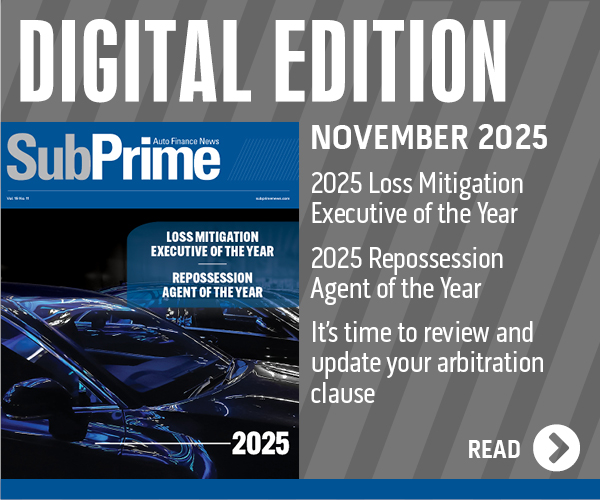San Francisco Fed offers new way to look at labor market & spot recessions

Image courtesy of the Federal Reserve Bank of San Francisco.
By subscribing, you agree to receive communications from Auto Remarketing and our partners in accordance with our Privacy Policy. We may share your information with select partners and sponsors who may contact you about their products and services. You may unsubscribe at any time.
The Federal Reserve Bank of San Francisco devised a new way of looking at the job market to provide more clarity to the auto-finance industry and the credit space in general.
The San Francisco Fed rolled out the Labor Market Stress Indicator (LMSI), which examines unemployment patterns across all 50 states and the District of Columbia. Rather than relying solely on national aggregates, Fed officials explained this indicator counts the number of states experiencing accelerating unemployment — defined as a state’s unemployment rate increasing at least 0.5 percentage point above its previous 12-month low.
Experts added it can be interpreted as a state-level version of the Sahm rule, which signals the start of a recession when the three-month moving average of the national unemployment rate rises by 0.50 percentage points or more relative to the minimum of the three-month averages from the previous 12 months.
Senior policy advisor Òscar Jordà and senior economist Sanjay Singh, who both are a part of the economic research department of the Federal Reserve Bank of San Francisco, elaborated about how the LMSI was created.
“This approach offers two main advantages over national aggregate measures,” Jordà and Singh wrote in a post on the San Francisco Fed website.
“First, it captures the geographic breadth of economic stress, distinguishing between localized downturns and widespread recessions. Second, it accounts for the fact that different states may experience varying labor market conditions due to regional economic structures and policies,” they continued.
Subscribe to Auto Remarketing to stay informed and stay ahead.
By subscribing, you agree to receive communications from Auto Remarketing and our partners in accordance with our Privacy Policy. We may share your information with select partners and sponsors who may contact you about their products and services. You may unsubscribe at any time.
Jordà and Singh offered a couple of examples of how the LMSI can be of assistance. They first pointed to a “false alarm” that happened last July. They explained why the Sahm rule red flag surfaced even though a recession wasn’t happening.
“A handful of large states — California, Texas, and New York — account for more than one-third of the U.S. labor force. An unusually large jump in any one of them can significantly impact the national unemployment rate, even if labor market conditions in most other states remain stable,” Jordà and Singh wrote.
“In July 2024, nearly 70% of the labor force resided in a state with accelerating unemployment, slightly below the 75% mark typically associated with recession calls,” they continued. “However, the share of states meeting our LMSI-based rule barely cleared the 30-state threshold and quickly fell within one month.
“By contrast, in every post-1980 recession, the LMSI and the share of the labor force in distress quickly climbed and stayed elevated for months. Hence, the more limited geographic pattern of distress and its very short duration were notably different from previous recessions,” Jordà and Singh went on to say.
Jordà and Singh also described what they said could be “canaries in the coal mine.”
They began by ranking states by the number of times during the previous 12 recessions they exhibited accelerating unemployment, as measured by the LMSI version of the state-level Sahm rule.
On one side of the spectrum were Illinois, Missouri, North Carolina, New Hampshire, Nevada, Ohio, Oregon, Pennsylvania, Rhode Island, South Carolina, Tennessee, and Washington. Jordà and Singh pointed out this group has flashed red in every single one of the past 12 recessions.
On the other side, Jordà and Singh indicated states like Nebraska, South Dakota, Kansas, North Dakota, Wyoming, Alaska, Hawaii, Iowa, New Mexico, Oklahoma, and Louisiana have flashed red less than half the time when a recession occurred in the national economy.
“What is different about that latter set of states that are not closely connected to national recessions, for example the Dakotas, Wyoming, and Alaska? These are states that rely heavily on industries that extract natural resources, where swings in the unemployment rate are less likely to be tied to the national business cycle,” Jordà and Singh wrote.
“These differences allow us to get a clearer picture of the sources of labor market stress that may have national implications from those that are more regional in nature,” they added.
Bottom line: what could this new tool mean for auto finance companies and other close watchers of the economy?
“The LMSI … provides a valuable complement to national recession indicators by revealing geographic variation in labor market weakness,” Jordà and Singh wrote. “The LMSI’s transparent methodology — simply counting states with accelerating unemployment — makes it easy to interpret while providing valuable insights into the geographic distribution of economic stress.
“This geographic lens becomes especially valuable when national indicators provide mixed or unclear signals about the state of the U.S. economy,” they continued.
“As of mid-2025, our indicator shows that the U.S. economy is not currently in recession and that labor market conditions remain relatively stable. The flexibility, clarity, and ease of interpreting the LMSI make it a useful addition to the standard tools used by economists, policymakers, and the public to monitor economic conditions,” they concluded.


